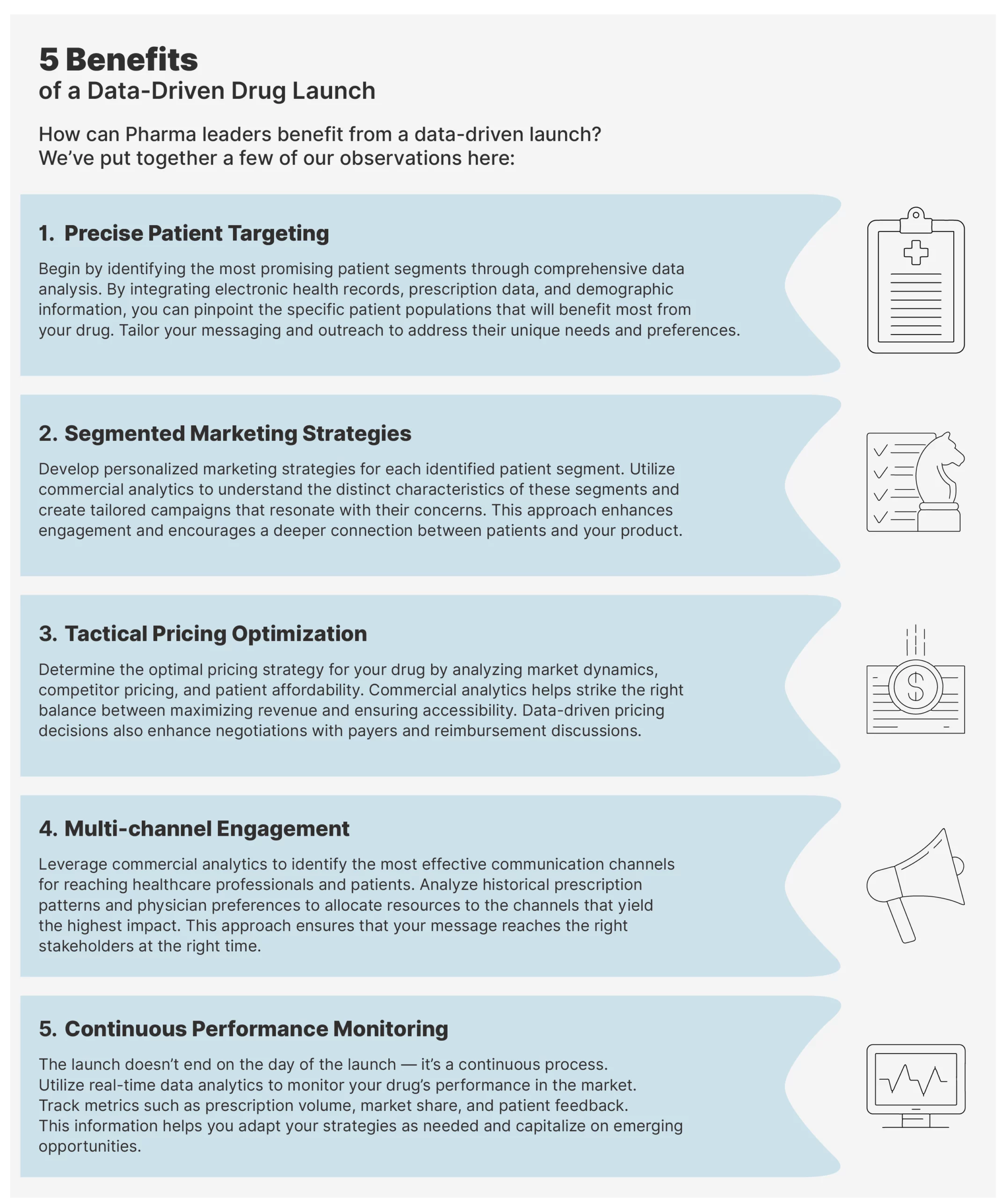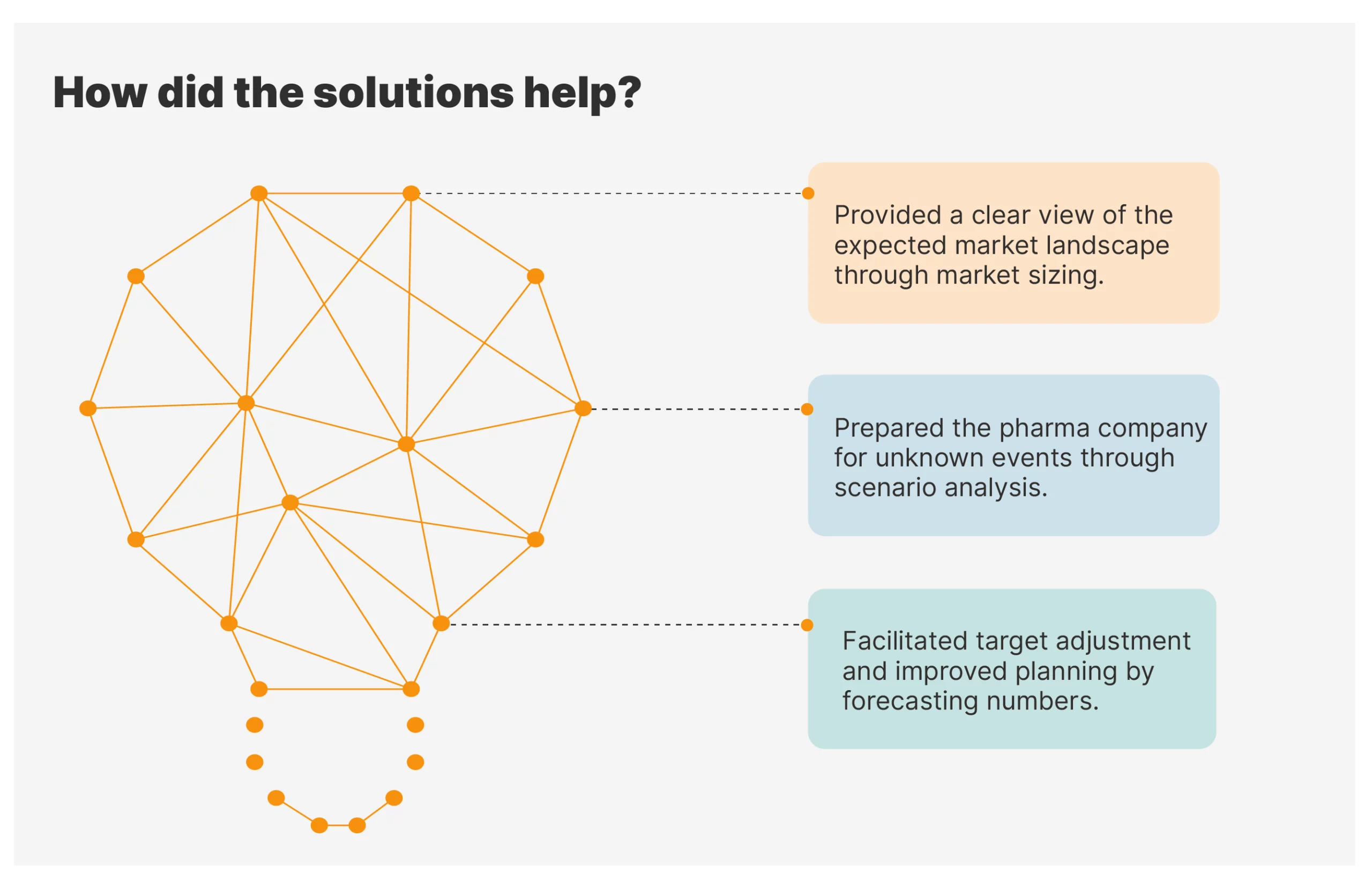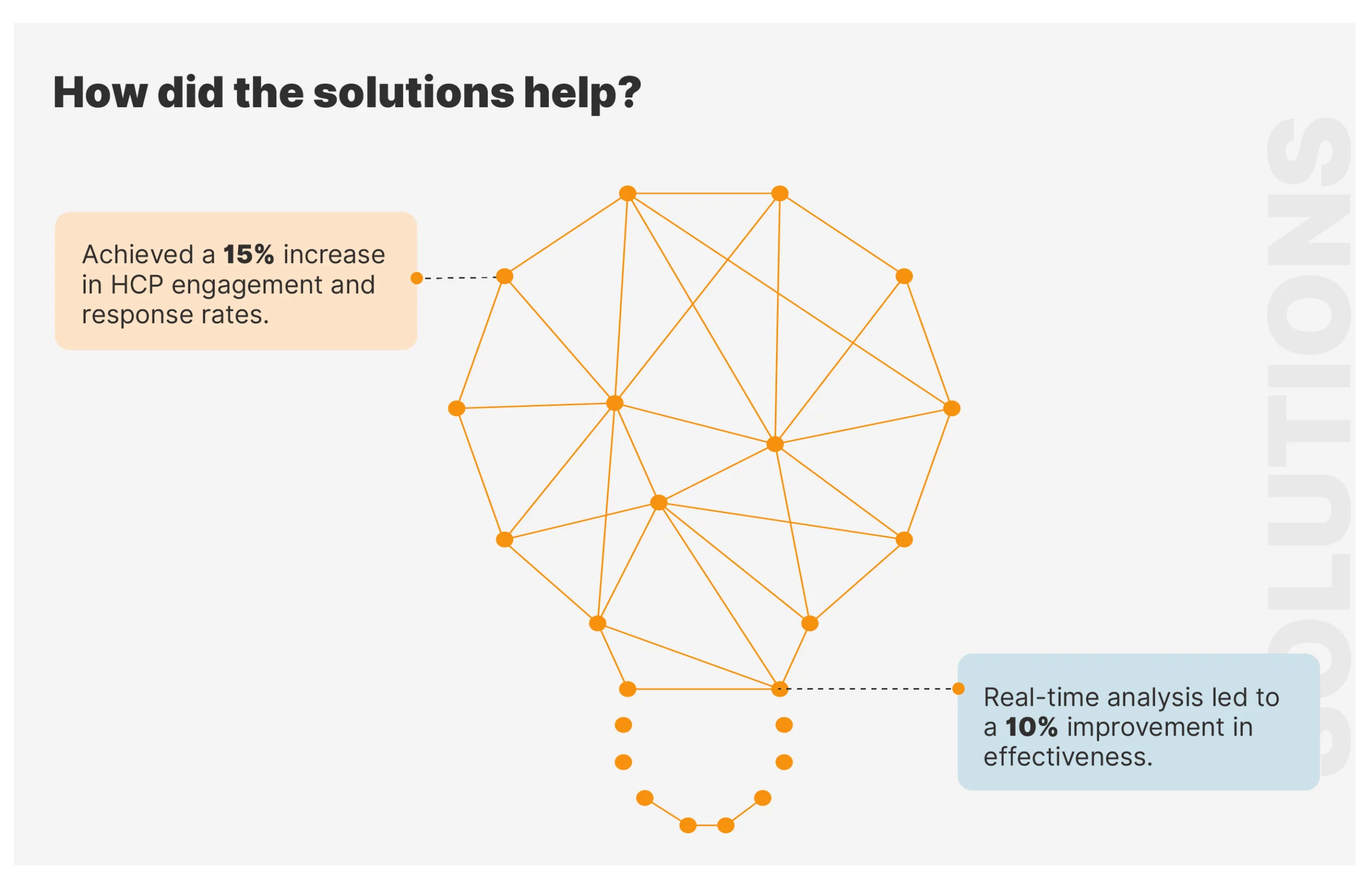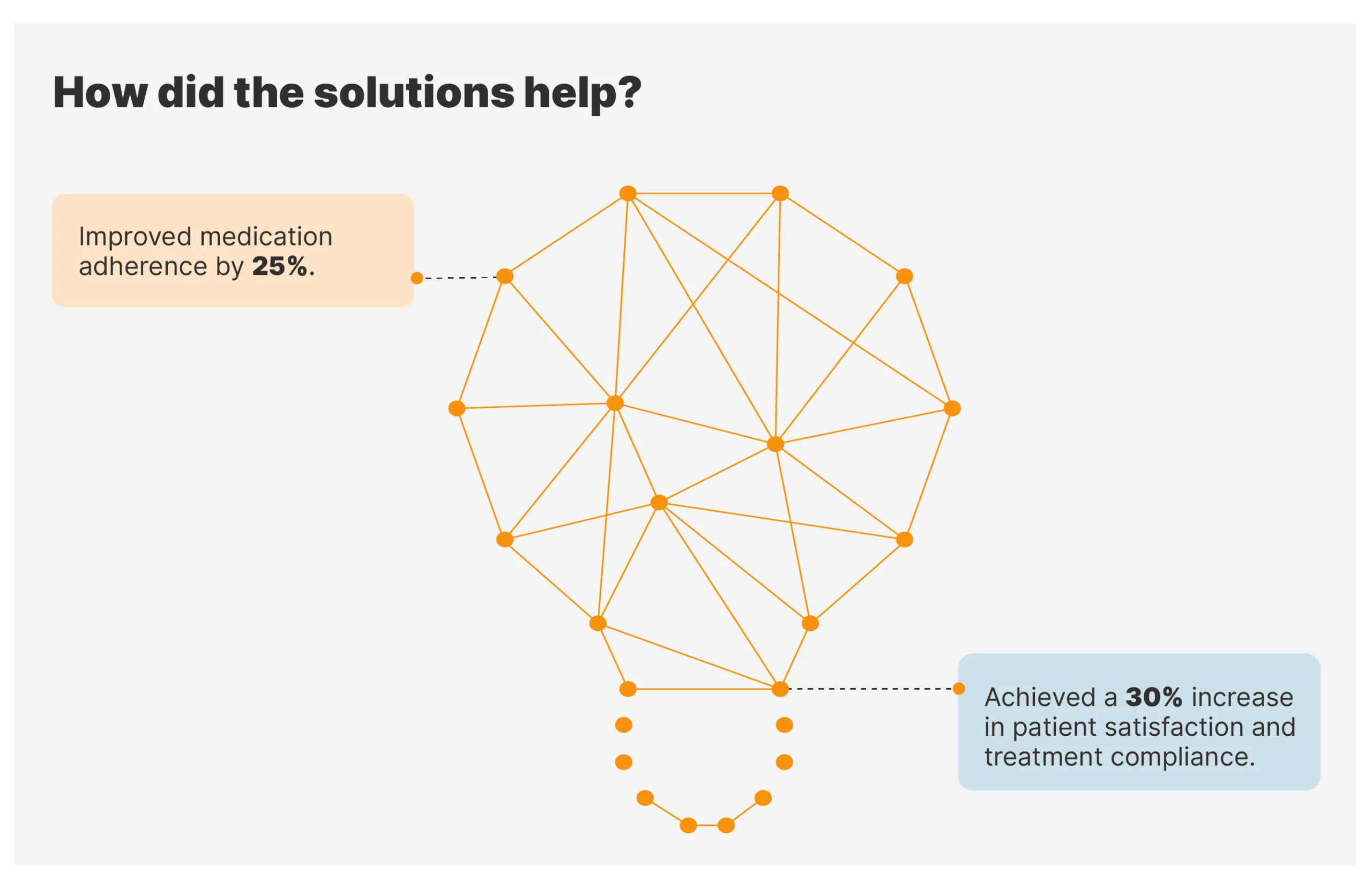For a Pharmaceutical company, launching a drug represents the culmination of extensive research and development efforts. Across the typical stages of drug launch – planning the launch, the launch itself, and the post-launch drug lifecycle management, Data Analytics can guide pharmaceutical companies to leverage the power of data-driven insights and strategic analysis. How does this help? According to research, for 85% of pharmaceutical launches, the product trajectory is set in the first six months.
Real-time analytics enables informed decision-making, enhanced patient outcomes, and creates a competitive edge for the drug in the ever-evolving Healthcare industry. A data-driven approach across the drug lifecycle ensures that the drug launch is not just a milestone, but a stepping stone towards improved healthcare and a brighter future.
5 Benefits of a Data-Driven Drug Launch
How can Pharma leaders benefit from a data-driven launch? We’ve put together a few of our observations here:

1. Precise Patient Targeting
Begin by identifying the most promising patient segments through comprehensive data analysis. By integrating electronic health records, prescription data, and demographic information, you can pinpoint the specific patient populations that will benefit most from your drug. Tailor your messaging and outreach to address their unique needs and preferences.
2. Segmented Marketing Strategies
Develop personalized marketing strategies for each identified patient segment. Utilize commercial analytics to understand the distinct characteristics of these segments and create tailored campaigns that resonate with their concerns. This approach enhances engagement and encourages a deeper connection between patients and your product.
3. Tactical Pricing Optimization
Determine the optimal pricing strategy for your drug by analyzing market dynamics, competitor pricing, and patient affordability. Commercial analytics helps strike the right balance between maximizing revenue and ensuring accessibility. Data-driven pricing decisions also enhance negotiations with payers and reimbursement discussions.
4. Multi-channel Engagement
Leverage commercial analytics to identify the most effective communication channels for reaching healthcare professionals and patients. Analyze historical prescription patterns and physician preferences to allocate resources to the channels that yield the highest impact. This approach ensures that your message reaches the right stakeholders at the right time.
5. Continuous Performance Monitoring
The launch doesn’t end on the day of the launch — it’s a continuous process. Utilize real-time data analytics to monitor your drug’s performance in the market. Track metrics such as prescription volume, market share, and patient feedback. This information helps you adapt your strategies as needed and capitalize on emerging opportunities.
Enabling a 360-Degree View of Pharma Drug Launch with Commercial Analytics
At Tiger Analytics, we developed a Data Analytics solution, tailored to meet the specific requirements of our clients in the Pharmaceutical industry. Our Commercial Analytics engine powers a suite of data-driven analytical interventions throughout the lifecycle of a drug. It serves as a bridge between goals and actionable insights, effectively transforming raw data into strategic decisions. The solution supports pre-launch patient segmentation and provider engagement. It also aids in launch-stage payer analytics and pharmacy optimization. Lastly, it enables post-launch patient journey analysis and outcomes assessment – giving Pharma leaders a 360-degree view of the entire launch cycle.
Here’s how it works:
Pre-Launch: Setting the Stage for Success
In this stage, the goal is to lay a strong foundation for success by developing the value proposition of the drug. Clinical teams, data strategists, and market researchers collaborate to assess the drug’s commercial potential and create a strategy to realize it. To begin, comprehensive surveys and market research are conducted to gain insights into healthcare personnel (HCP) behavior, competitor analysis, patient profiles, packaging analysis, price comparison, and sales benchmarks. These analyses shape the roadmap for the drug’s performance and enable the exploration of various scenarios through forecasting exercises. Patient profiling and segmentation strategies are also implemented to devise effective marketing and engagement strategies.
From Action to Impact
To drive tangible results, at Tiger Analytics we orchestrated a series of targeted initiatives with specific outcomes:
What did we do?
- Conducted a comprehensive analysis of analog drugs in the market and performed market scoping along with other forecasting exercises to understand the potential impact of the new drug once launched.
- Analyzed survey results and developed a tool to assess the possible effectiveness of the drug in real-world scenarios.
- Formulated multiple scenario analyses to account for unprecedented events and their potential impact on the demand for the drug.
How did the solutions help?
- Provided a clear view of the expected market landscape through market sizing.
- Prepared the pharma company for unknown events through scenario analysis.
- Facilitated target adjustment and improved planning by forecasting numbers.

Launch: Strategic Payer Engagement in a Complex Landscape
During the drug launch, the focus shifts to accelerating drug adoption and reducing the time it takes to reach peak sales. At this juncture, analytics plays a crucial role in optimizing market access and stakeholder engagement (payers, prescribers, and patients). By analyzing payer data, claims information, and reimbursement policies, pharmaceutical companies gain insights for strategic decision-making, including formulary inclusion, pricing strategies, and reimbursement trends. These insights enable effective negotiations with payers, ensuring optimal coverage and patient access to the medication.
Monitoring sales and identifying early and late adopters among HCPs and patients enables targeted marketing activities and tailored promotional initiatives. This approach effectively propelled successful market penetration.
From Action to Impact
To drive tangible results, we, at Tiger Analytics, orchestrated a series of targeted initiatives with specific outcomes:
What did we do?
- Implemented a robust email marketing campaign, targeting the identified early adopter HCPs.
- Monitored HCP engagement and response to emails using advanced analytics and tracking tools.
- Leveraged predictive models to conduct real-time analysis of promotional activities, optimizing their effectiveness and making data-driven adjustments.
How did the solutions help?
- Achieved a 15% increase in HCP engagement and response rates.
- Real-time analysis led to a 10% improvement in effectiveness.

Post-Launch: Empowering Patient-Centric Care
Post-launch analytics focuses on monitoring the market and adapting to market dynamics (competition, regulations, reimbursements, etc.) to extend the drug’s lifecycle. Advanced analytics also enables understanding a patient’s journey and optimizing the person’s medication adherence. By leveraging real-world data, electronic health records, and patient-reported outcomes, pharmaceutical companies gain invaluable insights into patient behavior, adherence rates, and treatment patterns. These insights facilitate the development of personalized interventions, patient support programs, and targeted educational campaigns to enhance patient adherence and improve treatment outcomes. Additionally, continuous tracking of the medication’s performance, market share, and patient-reported outcomes enables pharmaceutical companies to make data-driven decisions, generate evidence for stakeholders, and drive ongoing improvements in patient care.
From Action to Impact
To drive tangible results, we, at Tiger Analytics, orchestrated a series of targeted initiatives with specific outcomes:
What did we do?
- Utilized real-world data and electronic health records to track patient behavior and medication adherence.
- Conducted in-depth analysis of patient-reported outcomes to gain insights into treatment patterns and efficacy.
- Developed personalized interventions and patient support programs, based on the identified patterns and behaviors.
How did the solutions help?
- Improved medication adherence by 25%.
- Achieved a 30% increase in patient satisfaction and treatment compliance.

For Pharmaceutical companies, the goal of a successful drug launch is not only about accelerating the medicine’s time to market, but it is also about ensuring patient awareness and access to life-saving drugs. By leveraging the power of data to fuel AI-enabled drug launches, we’ll continue to see better medication adherance, satisfied patients, compliance to treatments – which will ultimately lead to better health outcomes.





